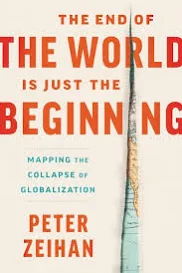Geopolitical strategist Peter Zeihan offers insights into the collapse of globalization and its potential consequences for major powers like China and Russia.

Globalization refers to the increasing interconnectedness of the world’s economies, cultures, and populations, facilitated by the cross-border trade of goods and services, advancements in technology, and the movement of investment, information, and people. Right now, there is an uncertain future of globalization.
After Russia’s invasion of Ukraine last year, concerns arose about the possibility of World War III. The Thucydides Trap, a concept highlighting rising trade tensions between the U.S. and China, added to these concerns.
(Thucydides, a fourth-century BC Athenian historian and general, wrote a book about the Peloponnesian War, a conflict between Athens and Sparta. He concluded that the war was inevitable due to the growth of Athenian power and the fear it caused in Sparta. This idea, the Thucydides Trap, has been generalized to suggest that when a rising power challenges a dominant power, war becomes unavoidable.)
However, China has shown no interest in aligning with Russia for such a war. Both China and Russia face obstacles that previous world powers like Stalin or Hitler did not. Today’s young people in China and Russia are well-informed through technology, and both countries face demographic challenges with an aging population and a shortage of young people.
Peter Zeihan, a geopolitical strategist and founder of Zeihan on Geopolitics, is an expert in various areas impacting world trade and economic growth. His insights shed light on the impact of a country’s geography, military strength, and vulnerability on major global events throughout history.
I’ve never come across anybody who has the breadth and depth of knowledge that Zeihan has in the areas he studies. I’ve read a great deal about matters that affect the stock market, but Zeihan’s books have filled in a lot of blanks for me.
Here are some quotes about China from Peter Zeihan’s website, Zeihan.com:
- The Americans are China’s single-biggest end-market and the Americans import more than triple from the Chinese than the other way around. In any tariff v tariff conflict the Chinese just don’t have much ammunition.
- The Chinese are the world’s largest exporters. Nearly all that trade is dependent upon the U.S. dollar-denominated and SWIFT-managed trading system. Should China befall American financial sanctions the China story would crash pretty quickly.
- The U.S. Navy has ten times the power of all other navies combined. Since World War II the Americans have used that imbalance to create a unified global system. Should that commitment fail — and it is — anyone dependent upon global trade is more or less screwed. Like, say, China. Making matters worse, nearly all Chinese trade with the rest of Asia is water-borne and therefore vulnerable.
 Instead of worrying about war with Russia and/or China or World War III, Zeihan’s main concern is right there at the end of the title of his latest book: “…the collapse of Globalization.”
Instead of worrying about war with Russia and/or China or World War III, Zeihan’s main concern is right there at the end of the title of his latest book: “…the collapse of Globalization.”
Hidden motives in Bretton Woods
I’ve written about the Bretton Woods agreement of 1944, and how it sidelined gold and catapulted the U.S. dollar into its position as the key currency throughout the world. However, there’s much more to it than that. For instance, how did the Americans get their wartime allies to go along with this plan?
The Bretton Woods agreement of 1944, which established the U.S. dollar as the world’s key currency, played a pivotal role in the post-World War II era of globalization. The U.S. offered its naval power to protect global commerce and opened its market to allied exports, creating an alliance against the Soviet Union. This agreement fostered economic growth and stability for several decades.
Containerized shipping and cost-effective Asian wages propelled globalization forward. Japan, with its Just-in-Time manufacturing process, took advantage of these opportunities and experienced significant economic growth. However, the U.S. struggled to adopt JIT manufacturing due to cultural and business practice differences. While Japan was expected to surpass the U.S. as the largest economy, its economy declined in the 1990s.
Recent trade disagreements between the U.S. and China, as well as supply chain disruptions caused by the COVID-19 pandemic, raised doubts about the future of globalization. Some experts refer to this period as the “New World Disorder.” Complex shipping patterns and tensions between countries make supply chains vulnerable. Major firms are considering changes to their supply chains to mitigate risks.
Peter Zeihan predicts significant changes or even a breakdown of globalization by the end of the decade. The U.S. economy, which used to be much larger than the rest of the world combined, now represents a smaller share. China, positioned at the furthest reaches of globalization, faces its own challenges. Its territorial disputes in the South China Sea and strained relations with Taiwan discourage foreign investors. China’s competition with other countries in terms of economics and foreign policy also poses challenges. Continue Reading…



